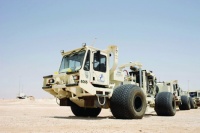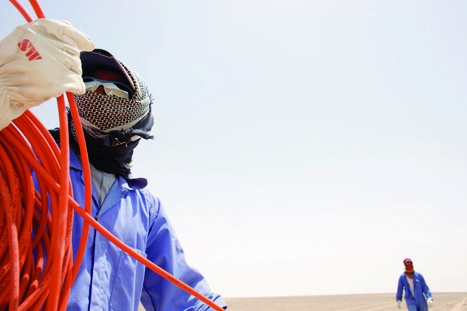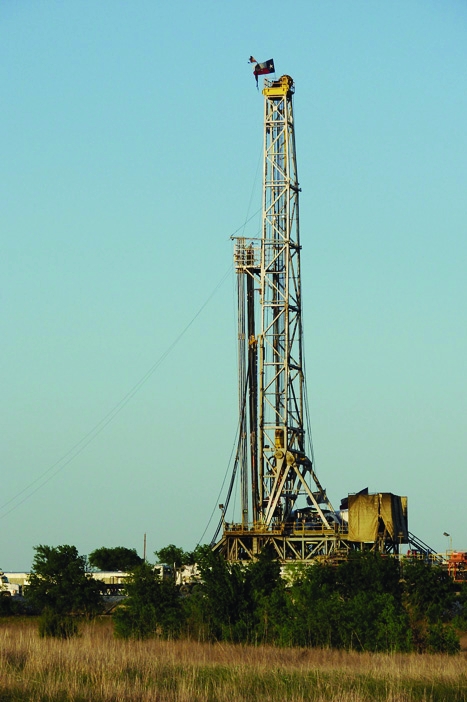Energy security is at the top of the agenda for many governments. Still overwhelmingly dependent on fossil fuels for power generation and transport, the West, in particular, relies heavily on imports from the Middle East, Russia and some of the former Soviet states. In many cases, the political situations in these countries make this reliance extremely uneasy.
But although research - and rhetoric - is looking towards alternative sources of energy and a resurgence of nuclear power, the energy infrastructure is still focused on fossil fuels and, in the case of power generation, this generally means gas. Not as cheap as coal, but far less polluting in terms of carbon emissions and other impurities, gas is the fuel of choice for most modern fossil-fuel power stations.
However, in the past few years, worries over gas security have begun to ease. The reason is the increased exploitation of a form of gas resource that’s very different from the familiar natural reservoir in porous rock. It’s known as shale gas.
Interest in shale gas, particularly in the US, has grown rapidly since around 2000. Reserves are vast and advances in technology have meant that previously inaccessible deposits - known as ’plays’ - are now producing large, economically viable volumes. Many players in the gas industry are now looking at deposits in Canada, Europe, Asia and Australia.


This technique has been exploited for many years in the US. ’The very first gas production in the US was from shale gas, in Fredonia, New York State, back in the 1820s,’ said Nigel Smith of the British Geological Survey, ’and shale-gas extraction carried on for some time. But it’s been technological advances that have fuelled the more recent expansion.’
Current shale-gas extraction uses a technique called hydraulic fracturing, often known as ’fracking’. A well is drilled through the upper strata into the shale bed, generally 1.5-6km below the surface, and a mixture of water and solid particles - often sand, sometimes manmade ceramic beads - is pumped down into the shale at pressures up to 100MPa (145,000psi). This fractures the rock and the solid particles hold the crack open. Because of this, the solid is known as a ’proppant’. This technique has been used since the 1940s.
The current expansion has resulted from the combination of fracking with horizontal drilling, which, in fact, refers to any direction of drilling that isn’t vertical. ’The problem with drilling for shale gas is that production tails off: you drill the hole, you make some fractures and you get a surge of gas that lasts a while, but as the gas from the shale surrounding the fracture runs out, it dies away,’ said Andy Aplin, professor of petroleum geology at Newcastle University, who is working on a project concerning shale-gas deposits in Western Canada. ’So, traditionally, you’d end up drilling a lot of holes near to the first one to find more. Horizontal drilling means that you don’t have to do so much of that.’
Advances in horizontal drilling in the late 1990s and during the last decade have seen the development of steerable drills that can keep drilling while changing direction, sending information back to the operator (often by modulating the pressure of the drilling mud that lubricates the drillbit). This has meant that operators can drill one main well then send the drill out in different directions through the shale, fracking where necessary to release the gas. As the horizontal bore tends to be through the gas-containing region of the shale, production rates remain reasonably high.
“Traditionally you’d end up drilling a lot of holes, but horizontal drilling means you don’t have to do that”
Andy Aplin, Newcastle University
Horizontal drilling has led to one of the major successes in US shale-gas exploration, in a play called the Barnett Shale in Texas. A huge reserve, spreading over an area of around 5,000 square miles (13,000km2), the Barnett is estimated to contain 850 billion cubic metres of natural gas reserves. The problem is, a lot of it is underneath the cities of Dallas and Fort Worth, and other populated areas. However, horizontal drilling has opened up these areas, sending the drillbits underneath residential areas and airports since it started in 2007.

But this hasn’t come without controversy. Researchers at the Jackson School of Geosciences have warned that fracking could put pressure on water supplies, endangering drinking water. With some 80 new wells being drilled every month, demand for water is already rising steeply.
There is also concern that fracking could itself be harmful to drinking water. Drills sometimes have to go through drinking-water acquifers and there have been cases of water being contaminated; in April, the state of Pennsylvania banned one company, Cabot Oil and Gas, from drilling, after combustible gas found its way into water supplies and a water well exploded. Shale-gas drilling in Colorado has also been controversial, with a documentary called ’Gasland’ showing people igniting gas coming off their household water supplies.
However, shale-gas exploration is continuing outside the US. ’Southern Sweden looks like it could be a fruitful area,’ said Nigel Smith, ’and there are also deposits in Austria, Poland and Germany.’ But, he added, Europe tends to be more heavily populated than the US, where shale-gas drilling is often in rather barren areas, and it could be difficult for companies to drill where they most want to. This isn’t likely to be a problem in another region with large shale-gas reserves - China, which is intending to produce 30 billion cubic metres of shale gas per year from as-yet unexploited sources.
The UK is also likely to hold some shalegas deposits, with areas such as the North Weald and the Northwest region under investigation. Population density and concerns over visual pollution are likely to make exploitation here even more difficult, Smith believes.
For much of Europe, therefore, the effect of shale gas might be somewhat different. Kash Burchett, energy analyst at Datamonitor, said that the mid-to-late1990s saw the US gear up for a massive increase in liquefied natural gas (LNG). ’That demand is now being met by shale and, as a result, there could be a large surplus in LNG,’ he said. ’And the effects of that haven’t been seen yet.’
in depth
coal-bed methane
The methane found in coal mines is the UK’s primary underground gas source
Although there are likely to be deposits of shale gas in the UK, the main source of gas from the ground here is more likely to be from coal mines. Coal-bed methane (CBM) as a possible source of natural gas has been investigated for some years and horizontal drilling might give producers access to new sources.
CBM is formed at the same time as coal, as part of the process that turns vegetable matter into hydrocarbons. It is adsorbed onto the surface of the coal itself or deposited into pores in the rock around the coal seam, but it isn’t alone: the methane is accompanied by other gases produced during coal formation, such as ethane, carbon dioxide, helium, nitrogen and hydrogen. However, the amounts of methane in coal seams can be five times the volume typically found in conventional gas reservoirs of the same size and conditions.
Of particular interest is the methane in abandoned mines. The UK was the sixth-largest producer of abandoned mine methane in 1990, although this wasn’t for energy as much as for safety - underground explosions can have lethal consequences on the surface. More recently, however, the focus has shifted.
’There are already lots of licences, some new wells and likely to be more,’ said Nigel Smith. There is a problem in the UK with the permeability of the coal, which tends to be low, he added, but horizontal drilling could be used to increase the flow rates.





Project to investigate hybrid approach to titanium manufacturing
What is this a hybrid of? Superplastic forming tends to be performed slowly as otherwise the behaviour is the hot creep that typifies hot...